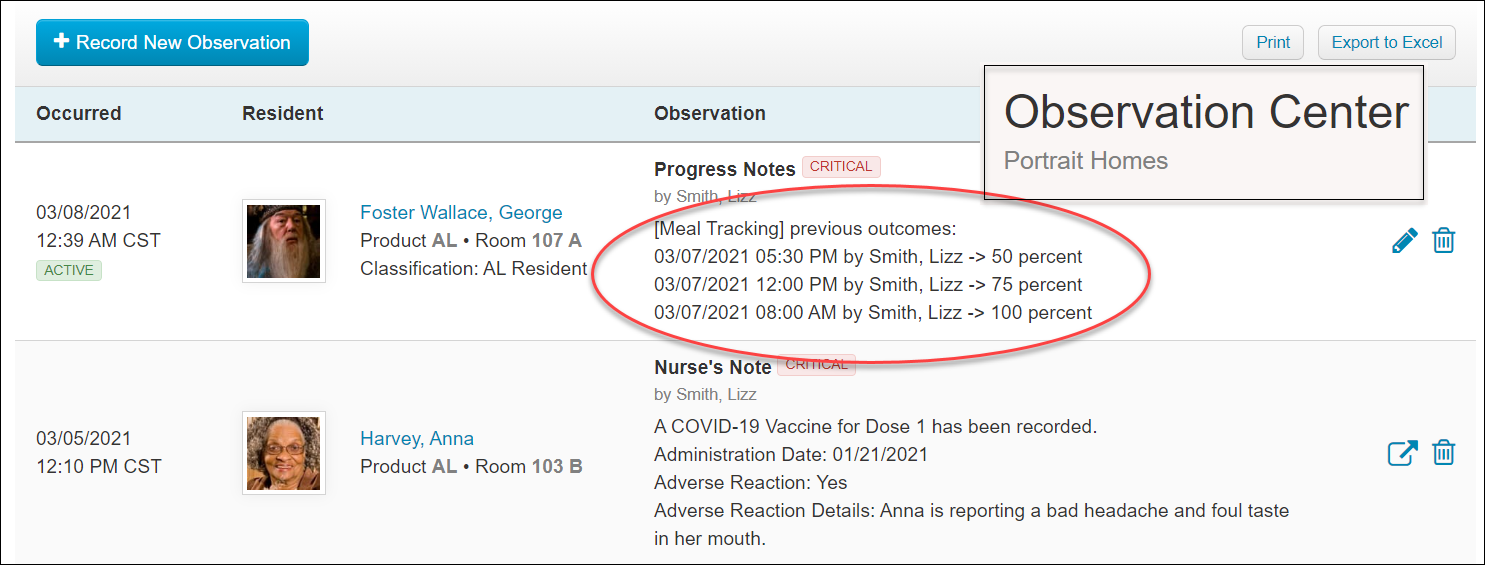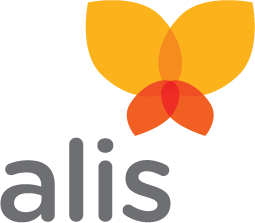Enhanced Care Tracking
This guide outlines how you can make the most out of your ADL task tracking in ALIS. We have several features optimized for timely intervention and communication of outcomes across your team!
Enhanced Care Item Features
The care item features outlined in sections below are:
- Custom Options for Possible Outcomes. This allows us to set a list of options for care staff to select.
- Show last outcomes during care tracking. This gives the Last 5 Recorded Outcomes table right on the Record Care page. Separately, the ‘View last 30 days outcomes’ link is always available for care staff if their security role allows it. This generates a document of outcomes.
- Allow broadcasting to Observations. This allows staff to create an Observation Note including recent outcomes for a Care Item right from the Record Care page. If the Care Item allows them to add notes, any notes are also included in the Observation.
Creating Observations from Care Tasks
BM Tracking
If you need to keep track of some residents’ BMs, ALIS can help you schedule checks for care shifts, and then report in the Observation Center if too much time has passed since the resident’s most recent BM.
- First, it is necessary to set up the care task in settings to utilize the enhanced communication features. The best practice for this is to display the last five outcomes in the Record Care page, and to allow notes to send to the Observation Center.
- Go to Settings > Care Settings. Click on the tab for the Care Program you are utilizing. This is most likely the tab simply called ‘Care’.
- Scroll down to the Toileting category, and click on it to expand the category. There should be an item called BM Tracking here, and if there isn’t use the +Add Item button to add it.
- Click the Edit button next to item to open the Edit Care Item pane from the right side of your screen. Notice the details including possible outcomes, and make sure you select the checkboxes “Show last outcomes during care tracking” and “Allow broadcasting to Observations”.
- In addition to these settings, it is a good practice to include in the instructions how your care team can see recent outcomes for the BM checks, and what they should do if too much time has passed since the most recent BM. A good example would be:
“If no BM recorded in the last 5 recorded outcomes, open the View last 30 days outcomes link. If the resident had no BM in the last 3 days, type a note and click Create an Observation with the Care Item’s Outcomes and Notes. Use the Type Progress Notes.”
- Adding instructions like the above go a long way toward helping any caregiver know exactly what to do for these checks!
- When you are done editing, click the Update Item button at the bottom right of the pane.

- Next, schedule this task for a resident on their ALIS Care Plan.
- On the Resident’s profile, scroll to the Care Plan section. Here we can click Create Draft and Edit in order to add the BM Tracking item.
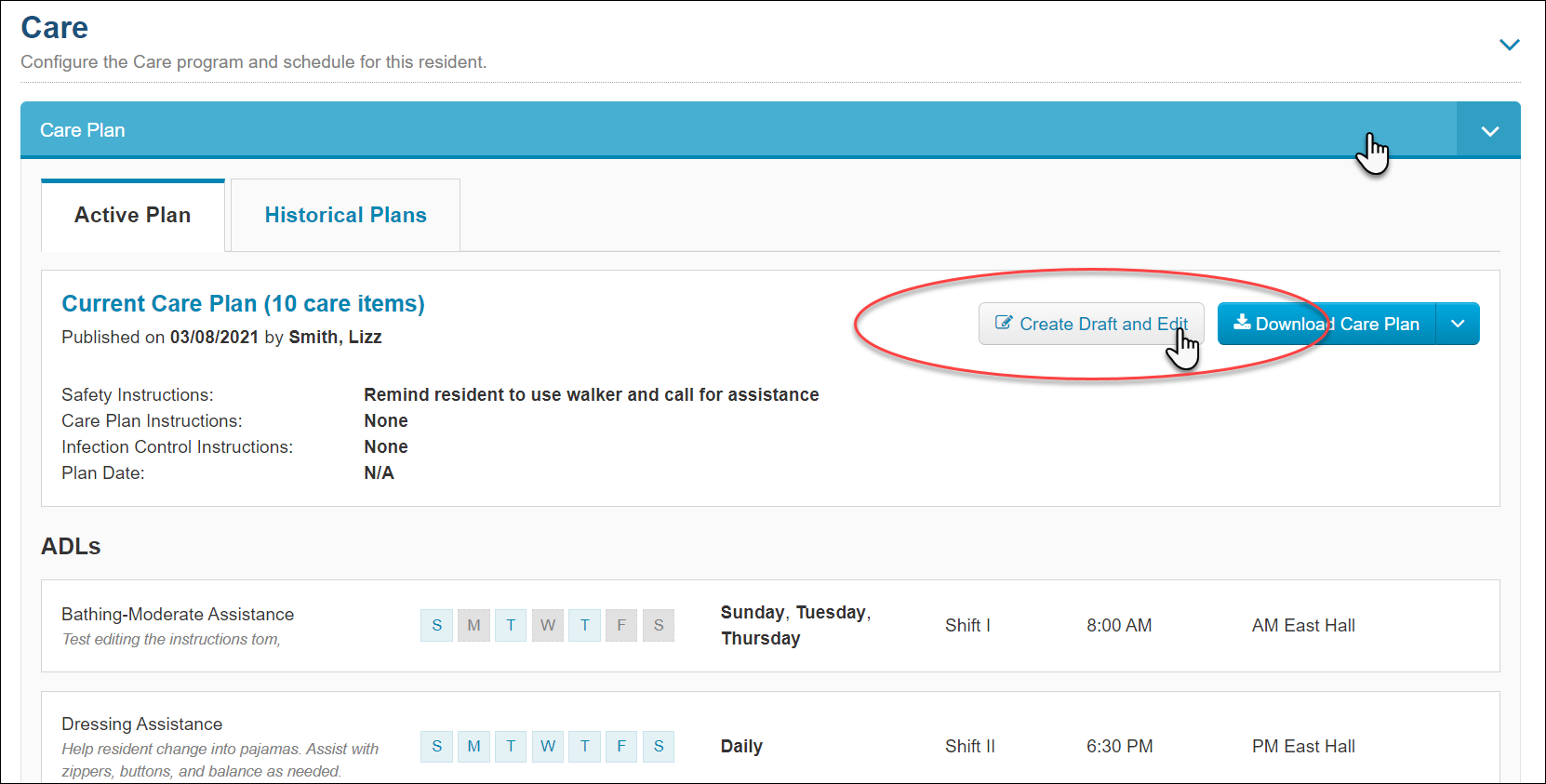
- Once you are in this draft plan, click the Add New Care Item to Plan button.
- This takes us to a separate page where we can select the BM Tracking item from the first menu, then customize any instructions, and set the schedule. The best practice for this item would be to schedule the care team to check two or three times daily. To do this, select “Daily” and “By shift” from the menus and then decide which times of day would be most appropriate to ask or check on the resident. Lastly, assign the checks to your Care Lists to the right of each selected time.
- Click the button at the bottom right Save and go back. When you are back on the resident’s Care Plan, click Publish when everything looks correct.
- On the Resident’s profile, scroll to the Care Plan section. Here we can click Create Draft and Edit in order to add the BM Tracking item.
- Going forward, your team who uses Care Tracking to document the schedule items will provide the outcomes needed to track your resident’s BMs. If they are instructed to do so, they will be creating Observation Notes to notify your clinical leadership if any interventions are necessary.
Meal and Hydration Tracking
If a resident’s meal or hydration intake must be tracked, ALIS can help you schedule checks for care shifts. The details can then be funneled into Observation Notes based on clear instructions for your care staff.
- First, it is necessary to set up the care task in settings to utilize the enhanced communication features. The best practice for this is to display the last five outcomes in the Record Care page, and to allow notes to send to the Observation Center.
- Go to Settings > Care Settings. Click on the tab for the Care Program you are utilizing. This is most likely the tab simply called ‘Care’.
- Scroll down to the Meals category, and click on it to expand the category. There should be items called Hydration Tracking and Meal Tracking here, and if there are not, use the +Add Item button to add them.
- Click the Edit button next to item to open the Edit Care Item pane from the right side of your screen. Notice the details including possible outcomes. If there are too many options, we can always delete some of these so that your care staff are choosing from a shorter list of outcome percentages. It is recommended you select the checkboxes “Show last outcomes during care tracking” and “Allow broadcasting to Observations”.
- In addition to these settings, it is a good practice to include in the instructions how your care team should look at recent outcomes for the intake checks, and what they should do if a resident has not been eating or drinking enough. An example would be:
“If the resident has not eaten at least 75% of their meals in the last 5 recorded outcomes, type a note and click Create an Observation with the Care Item’s Outcomes and Notes. Use the Type Progress Notes.”
- Adding instructions like the above go a long way toward helping any caregiver know exactly what to do for these checks!
- When you are done editing, click the Update Item button at the bottom right of the pane.
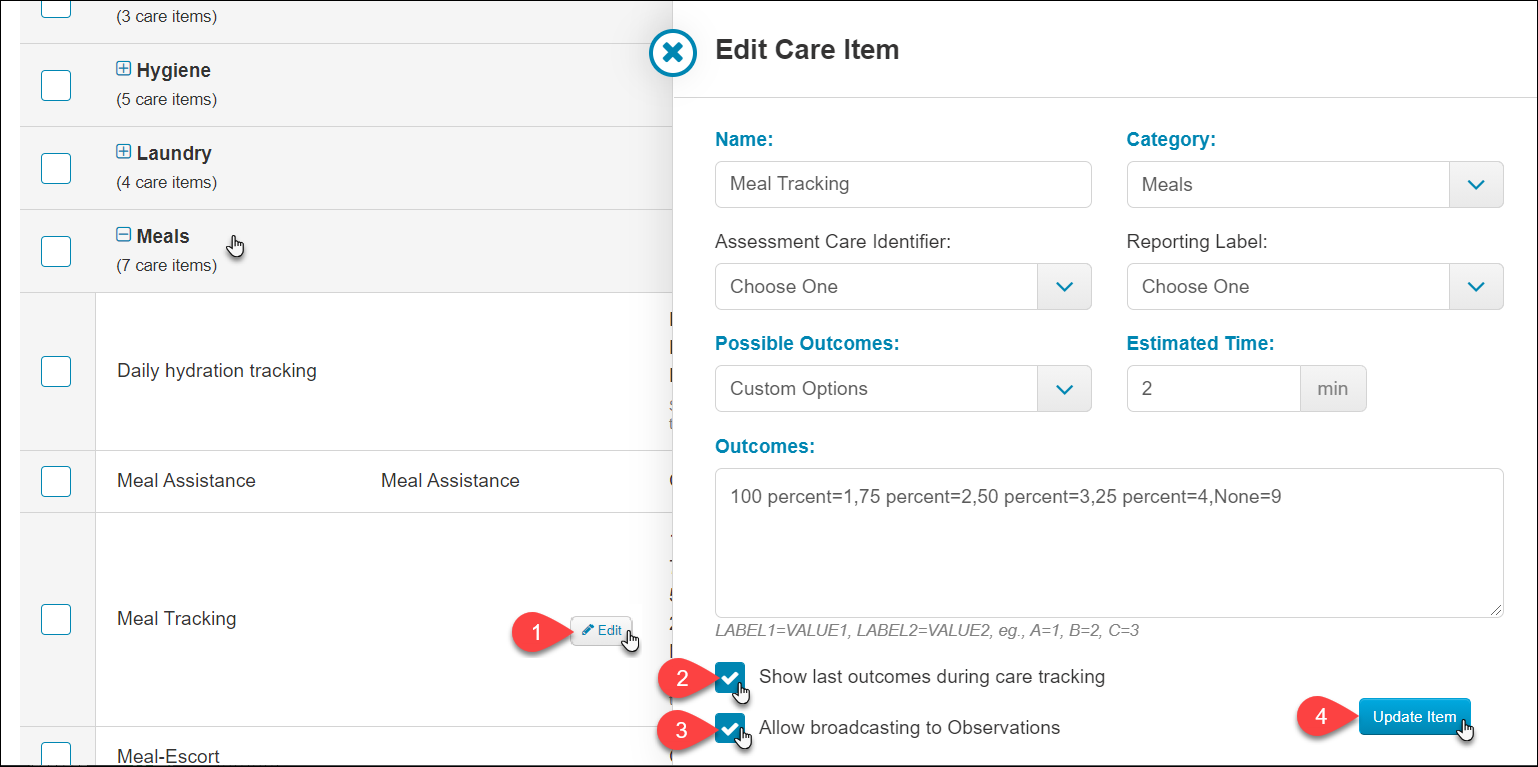
- Next, schedule this task for a resident on their ALIS Care Plan.
- On the Resident’s profile, scroll to the Care Plan section. Here we can click Create Draft and Edit in order to add the Hydration Tracking and/or Meal Tracking item.

- Once you are in this draft plan, click the Add New Care Item to Plan button.
- This takes us to a separate page where we can select the Meal Tracking or Hydration Tracking item from the first menu, then customize any instructions, and set the schedule. The best practice for this item would be to schedule the care team to check two or three times daily following the resident meal times. To do this, select “Daily” and “By shift” from the menus and then decide which times of day would be most appropriate to ask or check on the resident. Lastly, assign the checks to your Care Lists to the right of each selected time.
- Click the button at the bottom right Save and go back. When you are back on the resident’s Care Plan, click Publish when everything looks correct.
- On the Resident’s profile, scroll to the Care Plan section. Here we can click Create Draft and Edit in order to add the Hydration Tracking and/or Meal Tracking item.
- Going forward, your team who uses Care Tracking to document the schedule items will provide the outcomes needed to track your resident’s intake. If they are instructed to do so, they will be creating Observation Notes to notify your clinical leadership if any interventions are necessary.
Creating Observations from Care Tasks
The above-two sections cover how to set the ability for your care staff to record Observation Notes while they are documenting the care task outcomes. This is done by updating the Care Item settings for the specific tasks. Here we go over the experience of the caregiver in Care Tracking:
- When staff see their task on the Record Care page, they can review previously recorded outcomes and decide to create Observation Notes based on these. Specific instructions for the care items go a long way toward making sure they record the Observation Notes in the most useful way.
- Once they have recorded the item outcome and added any notes, they can select the checkbox next to Create an Observation with the Care Item’s Outcomes and Notes, select a note type, edit whether the note should be Critical or Normal Severity, and update the Keep Active For menu. Once everything looks right, everything is recorded and pushed to an Observation Note when they click the green Record Care button at the top right.
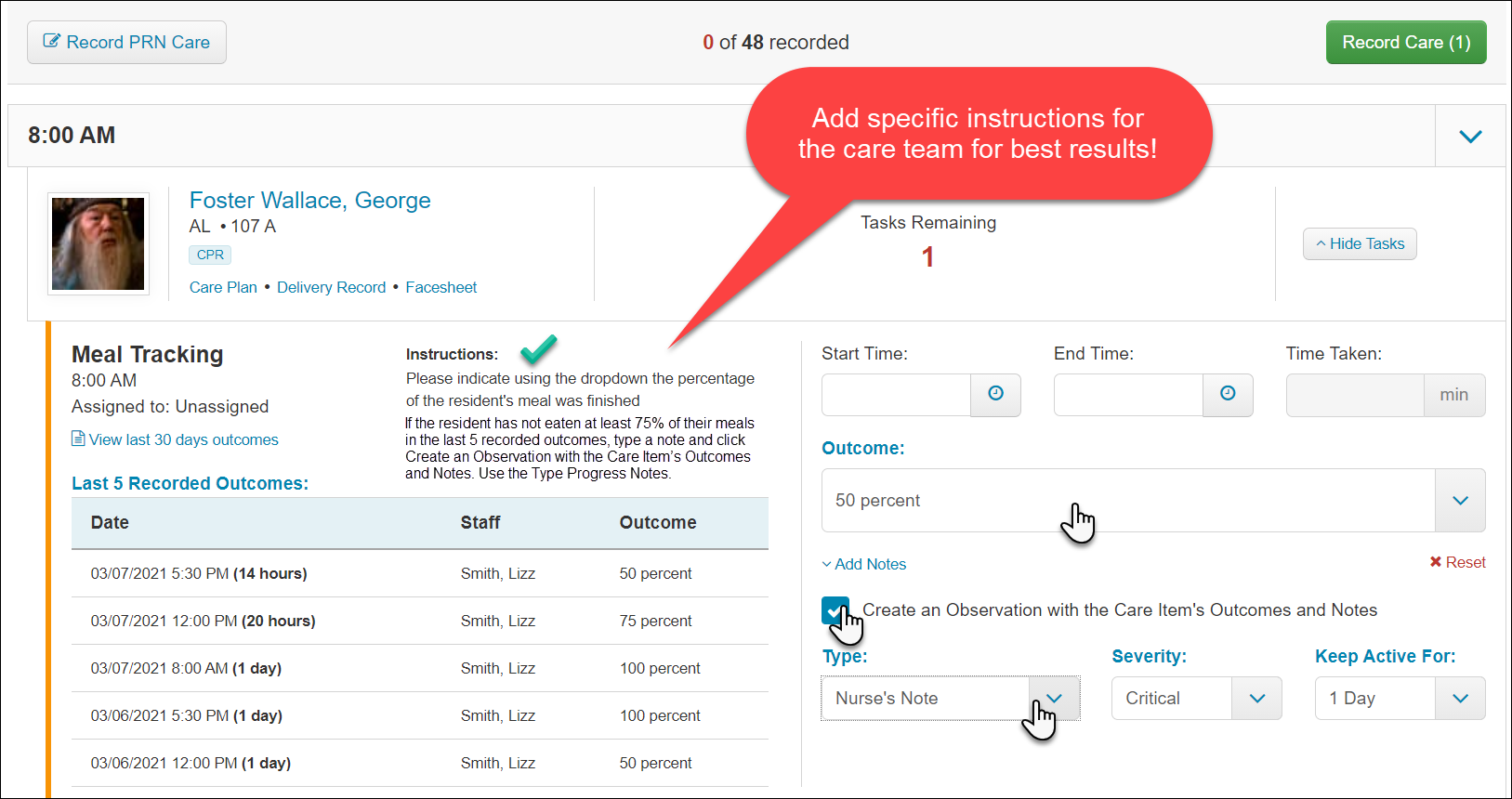
- Look in the Observation Center to see the note created from the Care Outcomes. This may just include the list of most recent outcomes, but will also include any notes added by the caregiver.
